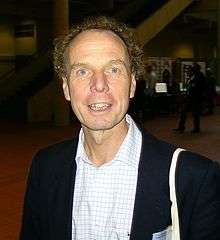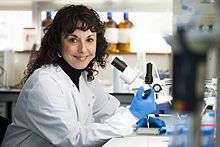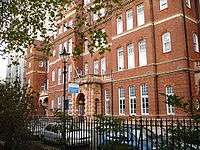UCL Institute of Neurology
|
UCL Institute of Neurology (left) and the National Hospital for Neurology and Neurosurgery (right) in Queen Square, London | |
| Established | 1950[1] |
|---|---|
| Director | Professor Michael G Hanna[2] |
Administrative staff | Around 500[3] |
| Students | Around 200 graduate students[3] |
| Location | London, United Kingdom |
| Website | UCL Institute of Neurology |
The UCL Institute of Neurology is an institute within the Faculty of Brain Sciences of University College London (UCL) and is located in London, United Kingdom.[1] Together with the National Hospital for Neurology and Neurosurgery, an adjacent facility with which it cooperates closely, the Institute forms a major centre for teaching, training and research in neurology and allied clinical and basic neurosciences.[4][5]
The Institute has a staff of around 500, an annual turnover of £53 million and occupies around 12,000 sq m of laboratory and office space.[3] Four of the 12 most highly cited authors in neuroscience and behaviour in the world are currently based at the Institute.[3] The Institute conducts research into a wide range of neurological diseases, including movement disorders, multiple sclerosis, epilepsy, brain cancer, stroke and brain injury, muscle and nerve disorders, cognitive dysfunction and dementia.[6] It forms a key part of UCL Neuroscience.[3]
History
The Institute of Neurology was established in 1950.[1] It merged with UCL in 1997, becoming the UCL Institute of Neurology.[1][7] The Institute is centred at Queen Square House, a concrete tower in the north-east corner of Queen Square, London that opened in 1971.[8] Due to expansion, some of the Institute's departments and activities are now based in numerous locations in Queen Square and surrounding parts of Bloomsbury.[3]
Departments
The Institute receives over £33 million per annum in research grants and currently holds over 300 active grants.[3] In the 2008 Research Assessment Exercise almost 100 staff were submitted for evaluation and 70% of research was deemed to be internationally competitive or world leading.[3] Submitted papers received an average citation rate of 40 per paper.[3]
The Institute is home to the following research departments and centres[9]
- Department of Brain Repair & Rehabilitation
- Department of Clinical and Experimental Epilepsy
- Department of Clinical Neuroscience
- Department of Molecular Neuroscience
- MRC Centre for Neuromuscular Disease
- Reta Lila Weston Institute of Neurological Studies
- Queen Square Brain Bank for Neurological Disorders
- UK Parkinson’s Disease Consortium
- Department of Neurodegenerative Disease
- Dementia Research Centre
- Dementias & Neurodegenerative Diseases Research Network (DeNDRoN)
- MRC Prion Unit
- Huntington's Disease Centre
- Department of Neuroinflammation
- Sobell Department of Motor Neuroscience and Movement Disorders
- Wellcome Trust Centre for Neuroimaging
The Institute also has active collaborative research programmes with the Institute of Cognitive Neuroscience, the Gatsby Computational Neuroscience Unit, Leonard Wolfson Experimental Neurology Centre and the Sainsbury Wellcome Centre for Neural Circuits and Behaviour.
Notable Research Findings
In November 2002, a team of researchers at the Institute led by Professor John Collinge published the results of a study which showed that the number of cases of CJD caused by the consumption of BSE-infected beef may have been higher than previously calculated and that BSE, in addition to causing variant CJD (vCJD), may also have caused some cases of "sporadic" CJD.[10]
In February 2004, a team of researchers at the Institute led by Tania Singer published research showing that it is possible for one human to feel another’s pain and that the same regions of the brain are activated in the empathizer and the empathisee.[11] In July 2005, a team of researchers at the Institute led by Davina Bristow published the results of research funded by the Wellcome Trust in Current Biology which demonstrated that parts of the human brain are temporarily "switched off" when blinking.[12]
In September 2005, a team of researchers at the Institute led by Victor Tybulewicz at the National Institute for Medical Research and Professor Elizabeth Fisher from the Institute published the results of a study in which they had been able to introduce most of a human chromosome into mice, producing the most successful recreation of Down's syndrome to date.[13]
In August 2007, a team of researchers at the Institute led by Henrik Ehrsson published research in Science which was the first to describe how it is possible to use cameras to trick the human brain into thinking that a person is elsewhere in a room than they really are.[14][15]
In February 2011, a team of researchers at the Institute led by Nick Wood published the results of a genetic study which had identified five new genes linked to Parkinson's disease.[16]
In September 2015, Prof Sarah Tabrizi began the first human trial of a 'gene silencing' antisense oligonucleotide drug, IONIS-HTTRx, for the neurodegenerative disease Huntington's disease at the Institute's Leonard Wolfson Experimental Neurology Centre.[17]
Notable researchers


Nobel Laureates
- James Rothman (Dept of Clinical & Experimental Epilepsy)
Fellows of the Royal Society
- Gillian Bates (Sobell Sobell Department of Motor Neuroscience and Movement Disorders)
- John Collinge (Dept of Neurodegenerative Disease)[18]
- Raymond Dolan (Wellcome Trust Centre for Neuroimaging)[19]
- John Hardy (Dept of Molecular Neuroscience)
- Geoffrey Raisman (Spinal Repair Unit)
- Elizabeth Warrington (Emeritus, Dementia Research Centre)
Fellows of the Academy of Medical Sciences
- John S. Duncan (Dept of Clinical and Experimental Epilepsy)
- Elizabeth Fisher (Dept of Neurodegenerative Disease)[20]
- Nick Fox (Dementia Research Centre)[21]
- Dimitri Kullmann (Dept of Clinical & Experimental Epilepsy)[22]
- Andrew Lees (Molecular Neuroscience)[23]
- Roger Lemon (Sobell Dept of Motor Neuroscience and Movement Disorders)[24]
- David Miller (Dept of Neuroinflammation)[25]
- Cathy Price (Wellcome Trust Centre for Neuroimaging)[26]
- Martin Rossor (Dementia Research Centre)[27]
- John Rothwell (Sobell Dept of Motor Neuroscience and Movement Disorders)
- Alan Thompson (Dept of Brain Repair and Rehabilitation)[28]
- Sarah Tabrizi (Huntington's Disease Centre)
Other notable researchers
- Michael Hanna (Institute Director and Dept of Molecular Neuroscience)
- Ley Sander (Department of Clinical and Experimental Epilepsy)
- Edward Wild (Huntington's Disease Centre)
Education
The Institute currently offers the following postgraduate-level courses:[29]
PhD programmes
- Three- and four-year PhD programmes
Masters programmes
- MRes in Translational Neurology
- MRes in Brain Sciences
- MSc/MRes in Advanced Neuroimaging
- MSc in Clinical Neuroscience
- MSc in Clinical Neurology
- Dual Masters in Brain and Mind Sciences
Diploma programmes
- Postgraduate Diploma in Clinical Neurology
- Postgraduate Diploma in Clinical Neurology via Distance Learning
Library
The Institute operates a joint library with the National Hospital for Neurology and Neurosurgery, which is located at the Institute.[30] The library is the recognised Library for Neurology within the University of London and contains an important collection of specialist neurology, neurosurgery and neuroscience books and journals, together with general medical and biomedical literature.[30] The archives hold a collection of pamphlets written by John Hughlings Jackson, the only such collection known to exist.[31] Holders of identity cards for the Institute, UCL, the National Hospital for Neurology and Neurosurgery or University College London Hospitals NHS Foundation Trust may become registered users.[30]
See also
- UCLH/UCL Comprehensive Biomedical Research Centre
- UCL Partners
- Francis Crick Institute
- Brain Research Trust
References
- 1 2 3 4 "Home". UCL Institute of Neurology. Retrieved 20 September 2010.
- ↑ "Officers". UCL Institute of Neurology. Retrieved 20 September 2010.
- 1 2 3 4 5 6 7 8 9 "About the Institute". UCL Institute of Neurology. Retrieved 9 October 2014.
- ↑ "Britain's best hospitals: A patients' guide". The Independent. 20 March 2008. Retrieved 19 April 2011.
- ↑ "World-class research". The Brain Research Trust. Retrieved 20 September 2010.
- ↑ Charles Clarke; Robin Howard; Martin Rossor; Simon D. Shorvon (2009), Neurology: A Queen Square Textbook, London, UK: John Wiley and Sons, retrieved 19 April 2011
- ↑ "The merger and the man". The Guardian. 22 October 2002. Retrieved 19 April 2011.
- ↑ "Queen Square Archive:Photographs: Queen Elizabeth the Queen Mother at the formal opening ceremony of Queen Square House".
- ↑ "Research Departments". UCL Institute of Neurology. Retrieved 9 October 2014.
- ↑ "BSE linked to further CJD cases". BBC News. 28 November 2002. Retrieved 19 April 2011.
- ↑ "Love means that you really do feel each other's pain". The Times. 20 February 2004. Retrieved 19 April 2011.
- ↑ "Blink and you really do 'miss it'". BBC News. 25 July 2005. Retrieved 19 April 2011.
- ↑ "Down's syndrome recreated in mice". BBC News. 22 September 2005. Retrieved 19 April 2011.
- ↑ "Out-of-body experiences are 'all in the mind'". New Scientist. 23 August 2007. Retrieved 19 April 2011.
- ↑ "Scientists study out-of-body experiences". USA Today. 23 August 2007. Retrieved 19 April 2011.
- ↑ "Scientists Find 5 New Parkinson's Genes". Fox News. 1 February 2011. Retrieved 19 April 2011.
- ↑ Gallagher, James (19 October 2015). "Landmark Huntington's trial starts". BBC News.
- ↑ "John Collinge". royalsociety.org.
- ↑ "Raymond Dolan". royalsociety.org.
- ↑ "Fellow | Academy of Medical Sciences". www.acmedsci.ac.uk.
- ↑ "Fellow | Academy of Medical Sciences". www.acmedsci.ac.uk.
- ↑ "Fellow | Academy of Medical Sciences". www.acmedsci.ac.uk.
- ↑ "Fellow | Academy of Medical Sciences". www.acmedsci.ac.uk.
- ↑ "Fellow | Academy of Medical Sciences". www.acmedsci.ac.uk.
- ↑ "Fellow | Academy of Medical Sciences". www.acmedsci.ac.uk.
- ↑ "Fellow | Academy of Medical Sciences". www.acmedsci.ac.uk.
- ↑ "Fellow | Academy of Medical Sciences". www.acmedsci.ac.uk.
- ↑ "Fellow | Academy of Medical Sciences". www.acmedsci.ac.uk.
- ↑ "Teaching & Education". UCL Institute of Neurology. Retrieved 9 October 2014.
- 1 2 3 "Guide to the Library & Library Services". Queen Square Library. Retrieved 20 September 2010.
- ↑ "Pamphlets of John Hughlings Jackson, Institute of Neurology, University College London". Medical History. Supplement. U.S. National Institutes of Health (26): 140. PMC 2640104
 .
.
External links
- UCL Institute of Neurology
- Queen Square Archives
- UCL School of Life and Medical Sciences
- University College London
- National Hospital for Neurology and Neurosurgery

